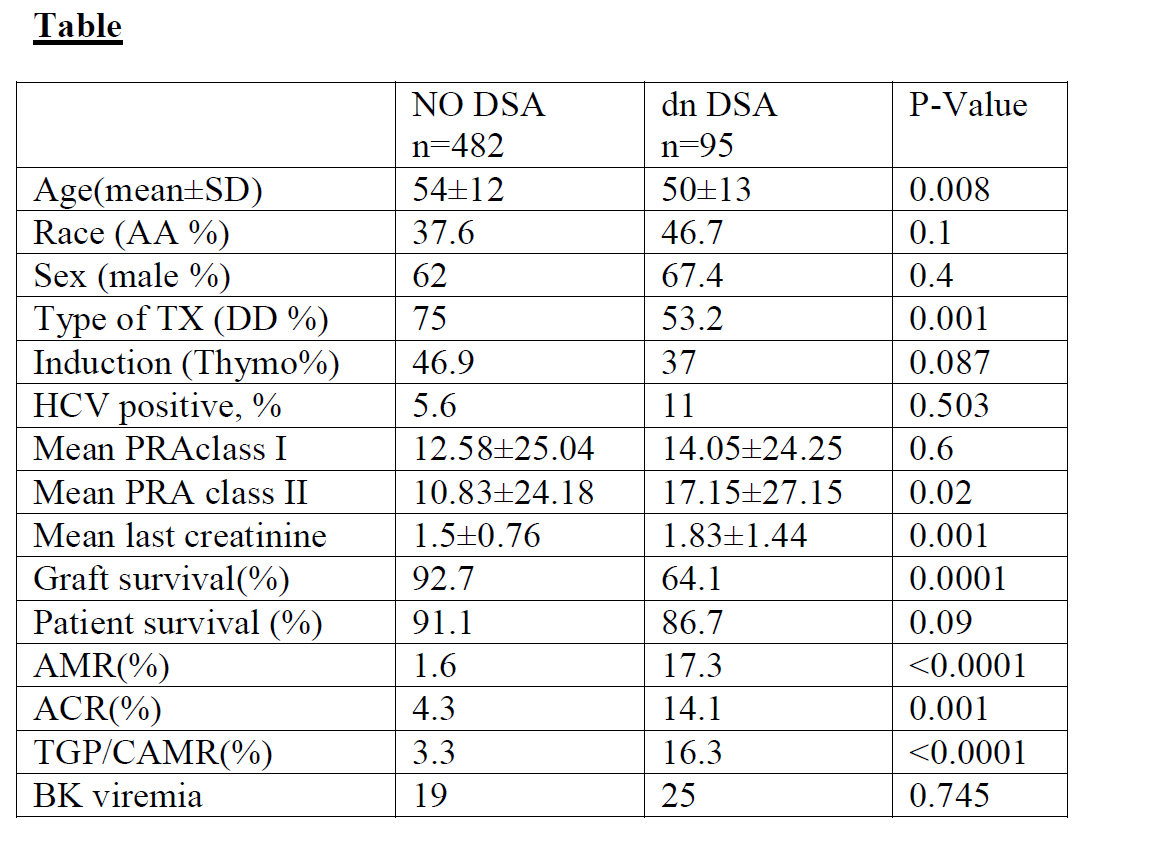Prospective Monitoring of De Novo Donor-Specific Antibodies: Incidence, Clinical Outcomes and Dynamic Changes Over 5 Years After Kidney Transplantation.
Montefiore Medical Center Transplant Center, Albert Einstein College of Medicine, Bronx
Meeting: 2017 American Transplant Congress
Abstract number: B67
Keywords: Alloantibodies, Kidney transplantation, Outcome
Session Information
Session Name: Poster Session B: Antibody Mediated Rejection in Kidney Transplant Recipients II
Session Type: Poster Session
Date: Sunday, April 30, 2017
Session Time: 6:00pm-7:00pm
 Presentation Time: 6:00pm-7:00pm
Presentation Time: 6:00pm-7:00pm
Location: Hall D1
Background: We aimed to investigate the incidence and dynamic changes of de novo donor-specific-antibodies (dnDSA) after kidney transplantation and clinical outcomes.
Methods: This is a prospective study including 556 non-HLA-identical patients who received a kidney transplant between January 2009 and December 2014 at our center without any preformed DSAs. Protocol testing for DSA via LABScreen single antigen beads was done before and at 1, 3, 12 months, and then annually after kidney transplantation or when clinically indicated. The cutoff value for DSA MFI was 1000 or greater.
Results: During a median 3.8 (2.4-5.3) years of follow-up, dnDSA developed in 95 patients (17%) at a mean of 20.3±13.3 months after kidney transplantation. There was no difference in terms of race, sex, HCV status, and mean class I PRA levels. dnDSA patients were younger, received less deceased-donor transplant and had higher mean class II PRA levels. dnDSA patients received less anti-thymocyte globulin induction (37% vs. 47%) but the difference was not significant (p=0.087). While there was no significant difference in patient survival, dnDSA group had lower graft survival (64.1% vs. 92.7%), higher acute antibody-mediated (17.3% vs. 1.6%) and T-cell mediated rejection (14.1 vs. 4.3%). Transplant glomerulopathy/chronic antibody-mediated rejection was more frequent in dnDSA patients (16.3% vs. 3.3%). There was no difference in terms of development of BKV viremia between the 2 groups. Of those 95 patients 83 had follow-up Luminex test and 49% had persistent DSA, 40% lost their DSA and 11% had their DSA MFI decreased by more than 50%. The mean sum MFI of dnDSA in the persistent group (9562.8±9409.1) was higher than the patients who lost their DSAs (4063.9±3487) or DSA MFI decreased by more than 50% (8768.7±4854.5).
Conclusions: 17% of our transplant recipients develop dnDSA after kidney transplantation and its associated with significantly higher acute and chronic rejection and lower allograft survival.
CITATION INFORMATION: Ajaimy M, Colovai A, Hayde N, Graham J, Lubetzky M, Kamal L, De Bocardo G, Akalin E. Prospective Monitoring of De Novo Donor-Specific Antibodies: Incidence, Clinical Outcomes and Dynamic Changes Over 5 Years After Kidney Transplantation. Am J Transplant. 2017;17 (suppl 3).
To cite this abstract in AMA style:
Ajaimy M, Colovai A, Hayde N, Graham J, Lubetzky M, Kamal L, Bocardo GDe, Akalin E. Prospective Monitoring of De Novo Donor-Specific Antibodies: Incidence, Clinical Outcomes and Dynamic Changes Over 5 Years After Kidney Transplantation. [abstract]. Am J Transplant. 2017; 17 (suppl 3). https://atcmeetingabstracts.com/abstract/prospective-monitoring-of-de-novo-donor-specific-antibodies-incidence-clinical-outcomes-and-dynamic-changes-over-5-years-after-kidney-transplantation/. Accessed December 22, 2025.« Back to 2017 American Transplant Congress

